Ijraset Journal For Research in Applied Science and Engineering Technology
- Home / Ijraset
- On This Page
- Abstract
- Introduction
- References
- Copyright
Development of Solar Powered Irrigation System in Gandhi Institute for Technology (GIFT), BBSR
Authors: Shweta Sahoo, Ritesh Kumar Maharna, Gopikrushna Samanta, Prof. Gayatri Mohanty, Dr. Satyananda Swain
DOI Link: https://doi.org/10.22214/ijraset.2022.42676
Certificate: View Certificate
Abstract
Sun is a tremendous source which creates energy through atomic parting of hydrogen cores into helium and as a side-effect of this delivered energy in the sun oriented radiations are produced. This sun based radiation then, at that point, strikes the earth surface and how much sun oriented radiation got by earth surface is around 1367 W (watt) per square meter. These sunlight based radiations can then be utilized for a few purposes like warming, The power creation in sun oriented warming can be by utilizing level plate gatherers which ingests and moves intensity to type of a liquid (water or air). The thought for this undertaking is to manufacture a solar pump that would be utilized on ranches. Sustainable power sources that are plentiful in nature and Solar Energy source particularly, has the ability to furnish energy prerequisites with right around zero outflow. The sun powered energy is accessible in enormous amounts and no other source in sustainable power has as much potential as sun oriented energy. The sun oriented controlled water siphoning framework can be utilized in all strolls of Works anyway it is broadly used and appropriate for provincial regions that witness energy emergency circumstances. A large number of these clients are excessively far away from an electrical framework to financially tap that can be utilized as a wellspring of force or motor driven siphoning framework that will in general be profoundly costly as well as untrustworthy because of the significant expense of bought fuel, lacking support and fix capacities. The arrangement of water pumping system in GIFT is done after a few examinations of an area getting great daylight. The assignment started with a thought of utilizing mulching method under this water system framework to look at dampness contrast and water maintenance period with and without mulching. Certain assortment of yields we planted to work out measure of water a plant utilizes at a typical rate at the same time determined water system productivity of the siphon Saving and reusing of water has turned into a central issue, where a sunlight-based fueled water system framework gives a decent reinforcement to water emergencies.
Introduction
I. INTRODUCTION
A. Present Water Situation in Odisha : Dug well based solar pump irrigation system in Odisha
Around 62% of the inhabitants in Odisha is subject to the farming job. The waterway-based water system framework covers under 20% of the absolute trimmed region of the state. Thus, ranchers in most pieces of the state are either subject to lift water system or pick development of a solitary downpour took care of harvest as it were.
Double-dealing of groundwater through the establishment of a Dug well is being taken up under the MGNREGS plan to increment the water system capability of the neighboring regions. The non-accessibility of electric power in rustic regions is deferring the empowerment of these DWs. A large number of such ventures are situated in remote cultivating regions having no power supply network.
Any place siphons are utilized unwavering quality of force supply and prudence/reasonableness of diesel makes a lot of block for viable utilization of these siphons. Investigating the accessibility of sunlight-based radiation of 5 kWh/m2/day separated from 60-70 stormy days with 300 clear bright days. SPV siphoning framework is probably the most ideal choice for the stimulation of such DWs. The establishment of the SPV framework will likewise address the continuous quality power supply in provincial regions. Sun-based energy is likewise a sustainable wellspring of energy that is liberated from cost and bounteously accessible in nature and above all it is ecofriendly. Our framework makes utilization of this sunlight-based radiation to deliver power which runs a farming water siphon. In this manner, the power expected to run the siphon is wiped out which eliminates the reliance of ranchers on matrix power.
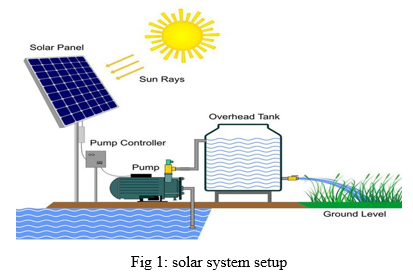
B. Components of solar pump setup
- Photovoltaic panels.
- DC/AC inverter.
- Induction motor.
- Centrifugal pump.
- Pipes, sockets and valve.
C. Benefits of Solar Pump
- Filling reservoirs,
- Supplying drinking water,
- Farm irrigation
- Supplying water for commercial use, for instance, in hotels
- Moving wastewater in sewage treatment plants
- Supplying water to construction sites or dewatering if water collects on the construction field
II. LITERATURE REVIEW
Vimal Chand Santoke et al.(2016) sun-oriented photovoltaic water siphoning framework (SPVWPS) has been a promising area of examination for over 50 years. In the mid-70s, endeavors and studies were embraced to investigate the chance of SPVWPS as an achievable, suitable, and affordable means of water siphoning. [1]
V.S Korpale et.al (2016) the sun-oriented photovoltaic based agrarian water siphoning framework is the most appropriate innovation for the water system of homesteads. Flimsy film Cd-Te sunlight-based chargers were utilized to control the 2HP existing water siphon. The exhibition of a sun-based controlled water siphon was just about as equivalent to a siphon fueled by a regular one. The productivity of sun-oriented-based water siphons is a lot higher than regular power-based water siphons. MPPT was utilized to follow the best working mark of sun based PV exhibit. The results of the announced study are significant having a financial effect on Indian rural areas. [2]
TNAU (2018) mulching is the cycle or practice of covering the dirt/ground to make better circumstances for plant development, improvement, and proficient harvest creation. Mulch specialized term signifies 'covering of soil'. While regular mulches, for example, leaf, straw, dead leaves, and fertilizer have been utilized for a really long time, during the most recent 60 years the approach of engineered materials has modified the strategies and advantages of mulching. [3]
J Pradhan, A Baliarsingh, S Pasupalak and AKB Mohapatra (2018) a field explore was completed during Rabi season 2017 at the Agrometeorological research ranch of College of Agriculture, Orissa University of Agriculture and Technology, Bhubaneswar to assess the satisfactory impact of the water system and mulching on groundnut (Arachis hypogea L.) efficiency. [4]
Desh Bandhu Singh and Anomol Mahajan (2020) concentrated on sun-oriented energy can possibly meet the prerequisite of energy for the endurance of individuals in the world earth whenever utilized shrewdly. A portion of the applications comprises of electric power age with the assistance of sunlight powered charger/thermoelectric generator/Rankine cycle-based innovation, water sanitization, dryer for horticulture item and refrigeration. [5]
S.K Sahoo and S.K Dwivedi's (2020) field explore in a split-plot configuration named "Impact of natural development and mulching on better assortments of turmeric" was embraced in rancher's field in West Central Table Land zone during Kharif 2007-08. The logical development of turmeric recorded the fundamentally bigger number of fingers slope 1 (12.21), new rhizome yield (18.093 t ha-1) and dry rhizome yield (4.682 t ha-1) than the fingers slope 1 (10.08), new rhizome yield (11.337 t ha-1 ) and dry rhizome yield (3.071t ha-1 ) created with rancher's development practice.[6]
The aftereffects of the recorded review make the financial impact on the Indian agrarian area significant[5]. This paper portrays a remote sensor network structure for minimal expense remote oversaw water system arrangement and continuous observing of soil water content. Information assortment is accomplished by the utilization of sunlight-based controlled remote assortment stations for water system valve control purposes. The machine has 3 units: Base Station Unit (BSU), Valve Unit (VU), and Sensor Unit (SU), separately. The water system framework acquired dodges tree dampness stress and salification as well as utilize freshwater energy [7]
III. METHODOLOGY
A. Objectives
- To fabricate solar pump
- To calculate pump power/efficiency
- To calculate pump’s discharge capacity
- To study effective irrigation method.
- Study the irrigation pattern of different crops in Odisha and increase its efficiency
B. Proposed System
The strategy of our undertaking will zero in on the designing angle and the business part of this task. The designing side of this task would manage how the sun-oriented fueled water system framework would work. The water system framework comprises two primary modules-Solar water siphoning module and the Automatic water system module.
The Solar siphoning module has the accompanying parts: a sunlight-based charger, a control circuit, and a water siphon fueled by the assistance of sun-powered energy. The framework utilizes a mulching procedure. The sunlight-based chargers of the wanted limit are utilized to produce electrical energy that can be utilized to drive the water siphon.
A converter circuit is an electric circuit used to change over the immediate flow (dc) delivered by means of a sunlight-based charger into substituting flow (ac). The water siphoned out will convey to the water system field by utilizing various lines, valves, and attachments. The water will be appropriated into the field as indicated by the water necessity by the harvest. The lift converter is utilized to switch DC over completely to DC's ability to expand the sunlight-based charger's result power since, in such a case that sunlight-based charger gets less light then support converter gives higher voltage contrasted with input voltage.
Whenever the switch is shut the ongoing moves through the inductor in a clockwise course and it stores some energy through the production of an attractive field. The ongoing will be diminished when the switch is opened, on the grounds that the impedance is higher. The recently made attractive field will be obliterated to safeguard the ongoing stream toward the charge.
- Hardware and Simulation
a. DC/AC Inverter
The Sun-based siphoning framework is a series-equal ingest daylight radiation energy through sunlight-based chargers and convert it into AC power by an inverter to drive diffusive siphon, water system siphon, pivotal stream siphon, blended stream siphon of profound well water siphon framework. As per the difference in the force of daylight, sun-oriented siphon inverter framework changes yield recurrence progressively, yielding power near the sun cell cluster most extreme power.
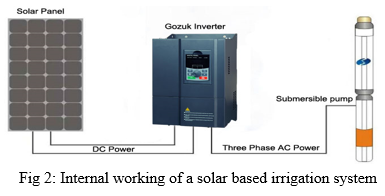
Sunlight-based siphon inverter, likewise named sun powered variable recurrence drive (VFD): electrical energy from photovoltaic sunlight-based chargers to drive AC engine water siphons.
- Inner with Maximum Power Point Tracking (MPPT) regulatory framework, it can follow the greatest force of sunlight-based chargers and is compelling to build the resultant force of the sunlight-based chargers.
- Execute work over the course of the day. It can work from dawn to dusk, extraordinarily further developing the water siphon's powerful working hours daily.
- Consequently adjust to changes and overcast climate. Really stay away from the conventional siphon unexpectedly cloudy, the framework will stop peculiarity.
- Framework has the solid enemy of sticking capacity, in the profundity of 200 meters, the framework can in any case be dependable work.
b. Induction Motor
An enlistment engine or non-concurrent engine is an AC electric engine wherein the electric flow in the rotor expected to create force is acquired by electromagnetic acceptance from the attractive field of the stator winding. An enlistment engine can subsequently be made without electrical associations with the rotor. An acceptance engine's rotor can be either wound type or squirrel-confine type.
Three-stage squirrel-confine enlistment engines are broadly utilized as modern drives since they are self-beginning, dependable, and affordable. Single-stage acceptance engines are utilized broadly for more modest burdens, for example, home devices like fans. Albeit generally utilized in fixed-speed administration, acceptance engines are progressively being utilized with variable-recurrence drives (VFD) in factor speed administration. VFDs offer particularly significant energy investment funds open doors for existing and forthcoming acceptance engines in factor force radial fan, siphon, and blower load applications. Squirrel-confine acceptance engines are broadly utilized in both fixed-speed and variable-recurrence drive applications.
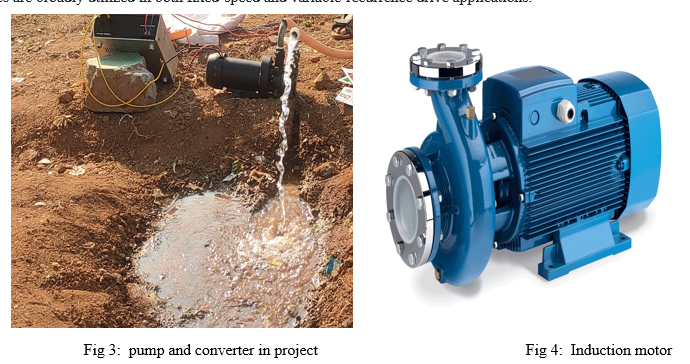
2. Use of mulching technique:
Mulching is mainly employed for,
- Moisture conservation in rainfed areas.
- Reduction of irrigation frequency and water saving in irrigated areas.
- Soil temperature moderation in greenhouse cultivation.
- Soil solarization for control of soil borne diseases.
- Reduce the rain impact, prevent soil erosion and maintain soil structure.
- In places where high value crops only to be cultivated.
a. Mulching Techniques for Vegetable
The extremely slender film is utilized for brief-term crops like vegetables. The required length of film for one line of harvest is taken and collapsed in the 'then' structure at each meter along the length of the film. Circular openings are made at the focal point of the film utilizing a punch or a greater width pipe and a mallet or a warmed line end could be utilized. One finish of the mulch film (along the width) is secured in the dirt and the film is unrolled along the length of the column of planting. Work the dirt well and apply the necessary amount of FYM and compost prior to mulching. Mulch film is then embedded (4-6") into the dirt on all sides to watch out for it. Seeds are planted straightforwardly through the openings made on the mulch film. If there should arise an occurrence of relocated crops, the seedlings could be planted straightforwardly into the opening. For mulching laid out seedlings, the most common way of poking the hole is something similar. One finish of the film along the width Is covered in the dirt and the mulch film is then unrolled over the saplings. During the method involved with unrolling, the saplings are 8 held in the hand and embedded into the openings on the mulch film from the base side, so they could spread the outdoors.
Water system Practices Under Mulching;
- In a trickle water system the parallel pipelines are laid under the mulch film.
- In case development should be completed, it is smarter to keep the laterals and drippers on top of the mulch film and control the progression of water through a little line or through the openings made on the mulch film.
- In flooding the water system water goes through the crescent openings on the mulching.

C. Experimental Area
Very importantly a proper site or location must be chosen that would give sufficient exposure to sunlight. Some criteria to look at are:
- A location that faces towards the south with limited shading.
- Sufficient area for the solar system elements such as the pump, tank, etc.
- The solar panels close enough to the pump which would help to reduce installation and wiring costs.
- Dry location in the case of battery use.
- It would be feasible to have the arrays located in an optimum location, as mentioned above, and also mechanize the PV array to tilt according to the sun's location, with the use of a tracker.
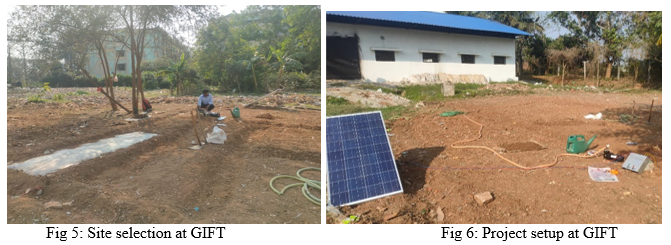
D. Statistics
Comparison Unmulched vs Mulch

E. Crop Water Requirement
First, we took some crop and find its water requirement, cropping period, irrigation process, temperature requirement, ph. and fertilizer requirement.
- Paddy
Water requirement
- Nursery – 50-60 mm
- Main field preparation- 200-250mm
- Planting to panicle initiation-400-550 mm
- Panicle initiation to flowering- 400-450 mm
- Flowering to maturity – 100- 150 mm.
Fertilizer requirement
- Short duration N P K – 120:40:40.
- Long duration N P K – 150: 50: 80.
2. Tomato
Water requirement
- 10 – 15 days – 0.5 -0.6 mm
- 20 – 30 days – 0.7 – 0.8 mm
- 30 – 40 days – 1.05 – 1.25 mm
- 40 – 50 days – 0.8 – 0.9 mm
- Harvesting – 0.62 – 0.65 mm.
Fertilizer Requirement
- Nitrogen- 100 – 150 kg/ha
- Phosphorous- 65 – 110 kg/ha
- Potassium – 160- 240kg/ha.
3. Green Gram
Water Requirement
- Before bed preparation – 75- 100 mm
- After sowing 35 days – 150- 200 mm
- After sowing 55 days – 75- 100 mm.
Fertilizer Requirement
- Nitrogen – 10 kg/ha
- Phosphorous- 30 kg/ha
- Bio fertilizer- 500 g of rhizobium culture / ha 2.5 packet/ ha (1 packet = 200g).
4. Chilly
Water Requirement
- Nursery 45 days- 200 mm
- Transplanting to flowering – 200 mm
- Flowering to pick up- 250 mm
- Fruit to maturing – 250mm
Fertilizer Requirement
- Nitrogen – 120 kg /ha
- Phosphorous – 20kg/ha
- Potassium – 30 kg/ha
F. Characteristic Solar Panel
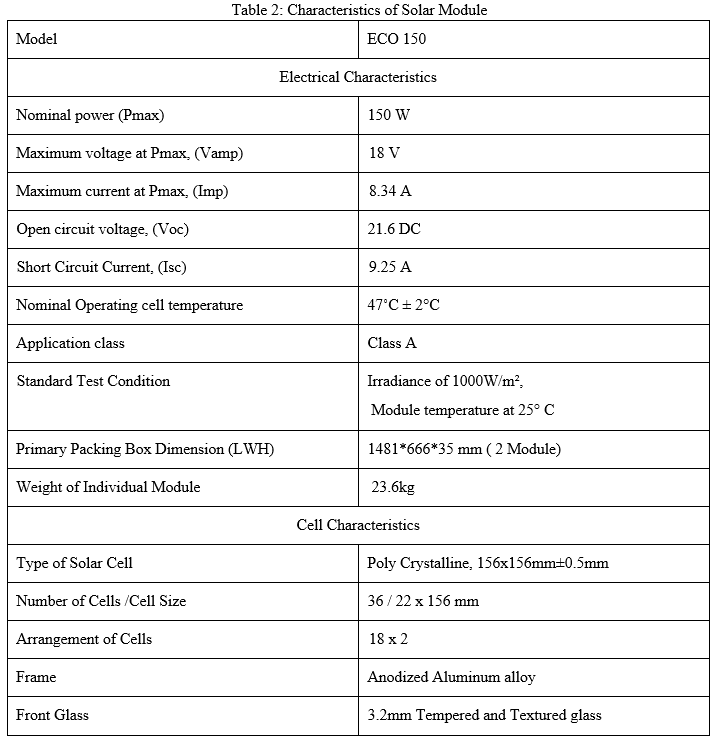
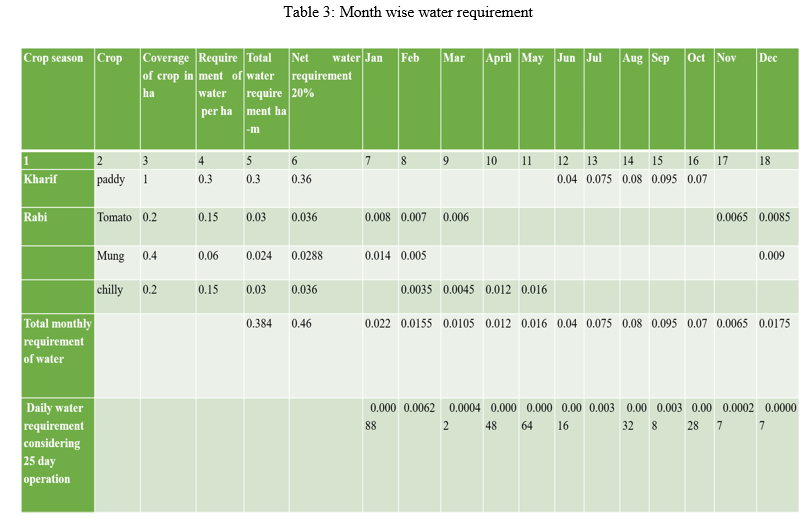
G. Comparison and Cost Estimation
Table 4: Comparison of Submersible vs Solar pump
|
Pump Type |
Submersible pump |
Solar submersible pump |
|
Power (Kw) |
0.75 |
0.75 |
|
Power (HP) |
1 |
1 |
|
Supply phase |
1 |
3 |
|
Pipe size (mm) |
30 |
32 |
|
No. of stages |
7 |
15 |
|
Head Range (m) |
12-43.0 |
30-80 |
|
Discharge Range |
120-140LPM |
110-150LPM |
|
MRP(INR) |
16,250.00/- |
80,000/- (including solar panel and installation) |
|
Warranty |
12 |
5 years on pump and 25 year on panel |
H. Cost Estimation for Solar pump
- Pump and Motor cost – 16 250/-
- Installation cost – 45,000/-
- Pipes and fittings – 10,000/-
- Solar panel required is 900 watts so we took 300-watt 3 panel and 1 panel cost is 7200/-, so total cost is 7200*3= 21, 000/-
- Solar inverter cost – 10, 000/-
- Total cost = 102,250/-
IV. RESULT AND DISCUSSION
After calculating above thing. From above calculation we found that we need a pump of 1hp.As we use submersible motor which has very less maintaining cost so only the initial cost is high but operating cost is less. Similarly, in solar pump also the initial cost is high and operating cost is low as compared to other power run variables displacement pump. Scheme for solar pump is KUSUM Yojana central government (60% bear by the central Govt. and 30% by state Govt.). Mulching also help to conserve the water and the sufficient water available to plant and we found the increase in the yield by 37.26 in case of tomato and 17.31 in case of chilly. In this project first of all we know how to design and the process of fabrication of a solar pump. Then we evaluated the pump to find out its efficiency We compared it with nonrenewable or electricity run pump to study the working of solar pump. The use of different mulching sheet according to plant and soul and climate conditions. Solar panel gives the energy needed to the water pump and control system.
V. ACKNOWLEDGMENT
We express my deep sense of gratitude and appreciation to Dr. Satyananda Swain (Head of the Department of Agricultural Engineering, GIFT Bhubaneswar), Prof. Gayatri Mohanty, of Agricultural Engineering for their constant and valuable guidance and help in implementing our project topic. They devoted their invaluable time in proving us the guidance at every step in our project. We would like to express gratitude to Dr. Ch V S Parameswara Rao Sir for providing us with this opportunity and for his great help and cooperation.
References
[1] Solar Photovoltaic water siphoning framework, Department of Mechanical Engineering, St. Vincent Pallotti College of Engineering and Technology, Nagpur, India. January 2016. [2] Performance evaluation of Solar Agricultural water siphoning framework, Department of General Engineering, Institute of Chemical Technology, Matunga Mumbai, India. December 2016. [3] Plastic Mulching for Crop Production, NAU - RI Block, Tamil Nadu Agricultural University, Lawley Rd, P N Pudur, Tamil Nadu. August 2018 [4] Agro Meteorological records corresponding to phenology and yield of promising sweet-smelling rice assortments of Odisha under various dates of Transplanting, Department of Agricultural Meteorology, College of Agriculture, Orissa University of Agriculture and Technology, Bhubaneswar, Odisha. February 2018. [5] H. Suresh, V. Umasankar, V. Thulasi, S. Harishankar, R. Sathish Kumar, and U. Vignesh, \"Sun oriented Powered Smart Irrigation System,\" Res. India Publ., 2014. [6] Abdelkerim, M. M. R. S. Eusuf, M. J. E. Salami, A. Aibinu, and M. A. Eusuf, \"Improvement of sun based controlled water system framework,\" 2013, doi: 10.1088/1757-899X/53/1/012005. [7] O. Deveci, M. Onkol, H. O. Unver, and Z. Ozturk, \"Plan and advancement of a minimal expense sunlight based fueled dribble water system framework utilizing Systems Modeling Language,\" J. Clean. Nudge., 2015, doi: 10.1016/j.jclepro.2015.04.124. [8] S. V and S. W. S, \"Sun oriented photovoltaic water siphoning framework for water system: An audit,\" African J. Agric. Res., 2015, doi: 10.5897/ajar2015.9879. [9] S. Korpale, D. H. Kokate, and S. P. Deshmukh, \"Execution Assessment of Solar Agricultural Water Pumping System,\" 2016, doi: 10.1016/j.egypro.2016.11.219. [10] M. Dursun and S. Ozden, \"A remote utilization of dribble water system mechanization upheld by soil dampness sensors,\" Sci. Res. Expositions, 2011, doi: 10.5897/SRE10.949. [11] Fathah, \"Plan of a Boost Converter,\" Fathah, A. (2013). Des. a Boost Convert. 2. Recovered from http//ethesis.nitrkl.ac.in/4811/1/109EE0612.pdf, 2013.
Copyright
Copyright © 2022 Shweta Sahoo, Ritesh Kumar Maharna, Gopikrushna Samanta, Prof. Gayatri Mohanty, Dr. Satyananda Swain. This is an open access article distributed under the Creative Commons Attribution License, which permits unrestricted use, distribution, and reproduction in any medium, provided the original work is properly cited.

Download Paper
Paper Id : IJRASET42676
Publish Date : 2022-05-14
ISSN : 2321-9653
Publisher Name : IJRASET
DOI Link : Click Here
 Submit Paper Online
Submit Paper Online

